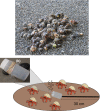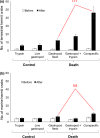Scent of death: Evolution from sea to land of an extreme collective attraction to conspecific death
- PMID: 30847102
- PMCID: PMC6392395
- DOI: 10.1002/ece3.4912
Scent of death: Evolution from sea to land of an extreme collective attraction to conspecific death
Abstract
All living organisms must eventually die, though in some cases their death can bring life-giving opportunities. Few studies, however, have experimentally tested how animals capitalize on conspecific death and why this specialization would evolve. Here, we conducted experiments on the phylogenetically most closely-related marine and terrestrial hermit crabs to investigate the evolution of responses to death during the sea-to-land transition. In the sea, death of both conspecifics and heterospecifics generates unremodeled shells needed by marine hermit crabs. In contrast, on land, terrestrial hermit crabs are specialized to live in architecturally remodeled shells, and the sole opportunity to acquire these essential resources is conspecific death. We experimentally tested these different species' responsiveness to the scent of conspecific versus heterospecific death, predicting that conspecific death would have special attractive value for the terrestrial species. We found the terrestrial species was overwhelmingly attracted to conspecific death, rapidly approaching and forming social groupings around conspecific death sites that dwarfed those around heterospecific death sites. This differential responsiveness to conspecific versus heterospecific death was absent in marine species. Our results thus reveal that on land a reliance on resources associated exclusively with conspecifics has favored the evolution of an extreme collective attraction to conspecific death.
Keywords: collective behavior; death; evolutionary innovation; sea to land; shells; sociality.
Conflict of interest statement
Authors declare no competing interests.
Figures



Similar articles
-
Social conquest of land: Sea-to-land changes in shell architecture and body morphology, with consequences for social evolution.Arthropod Struct Dev. 2021 Jul;63:101064. doi: 10.1016/j.asd.2021.101064. Epub 2021 Jun 4. Arthropod Struct Dev. 2021. PMID: 34098322
-
Volatile shell-investigation cues of land hermit crabs: Effect of shell fit, detection of cues from other hermit crab species, and cue isolation.J Chem Ecol. 1994 Jul;20(7):1457-82. doi: 10.1007/BF02059873. J Chem Ecol. 1994. PMID: 24242644
-
Architectural modification of shells by terrestrial hermit crabs alters social dynamics in later generations.Ecology. 2019 Sep;100(9):e02767. doi: 10.1002/ecy.2767. Epub 2019 Jun 28. Ecology. 2019. PMID: 31162638
-
Friendship across species borders: factors that facilitate and constrain heterospecific sociality.Philos Trans R Soc Lond B Biol Sci. 2018 May 19;373(1746):20170014. doi: 10.1098/rstb.2017.0014. Philos Trans R Soc Lond B Biol Sci. 2018. PMID: 29581399 Free PMC article. Review.
-
Eavesdropping on heterospecific alarm calls: from mechanisms to consequences.Biol Rev Camb Philos Soc. 2015 May;90(2):560-86. doi: 10.1111/brv.12122. Epub 2014 Jun 11. Biol Rev Camb Philos Soc. 2015. PMID: 24917385 Review.
Cited by
-
Individualism versus collective movement during travel.Sci Rep. 2022 May 7;12(1):7508. doi: 10.1038/s41598-022-11469-1. Sci Rep. 2022. PMID: 35525848 Free PMC article.
-
Doors to the Homes: Signal Potential of Red Coloration of Claws in Social Hermit Crabs.Integr Org Biol. 2023 May 22;5(1):obad018. doi: 10.1093/iob/obad018. eCollection 2023. Integr Org Biol. 2023. PMID: 37323238 Free PMC article.
-
Shells as 'extended architecture': to escape isolation, social hermit crabs choose shells with the right external architecture.Anim Cogn. 2020 Nov;23(6):1177-1187. doi: 10.1007/s10071-020-01419-7. Epub 2020 Aug 8. Anim Cogn. 2020. PMID: 32770436 Free PMC article.
-
Wild social behavior differs following experimental loss of vision in social hermit crabs.Naturwissenschaften. 2023 May 18;110(3):20. doi: 10.1007/s00114-023-01847-8. Naturwissenschaften. 2023. PMID: 37199869
-
Finding a home in the noise: cross-modal impact of anthropogenic vibration on animal search behaviour.Biol Open. 2019 Jul 10;8(7):bio041988. doi: 10.1242/bio.041988. Biol Open. 2019. PMID: 31292133 Free PMC article.
References
-
- Bates, K. M. , & Laidre, M. E. (2018). When to socialize: Perception of time‐sensitive social structures among social hermit crabs. Animal Behaviour, 138, 19–27. 10.1016/j.anbehav.2018.01.024 - DOI
-
- Biro, D. , Humle, T. , Koops, K. , Sousa, C. , Hayashi, M. , & Matsuzawa, T. (2010). Chimpanzee mothers at Bossou, Guinea carry the mummified remains of their dead infants. Current Biology, 20, R351–R352. - PubMed
Associated data
LinkOut - more resources
Full Text Sources
Other Literature Sources

